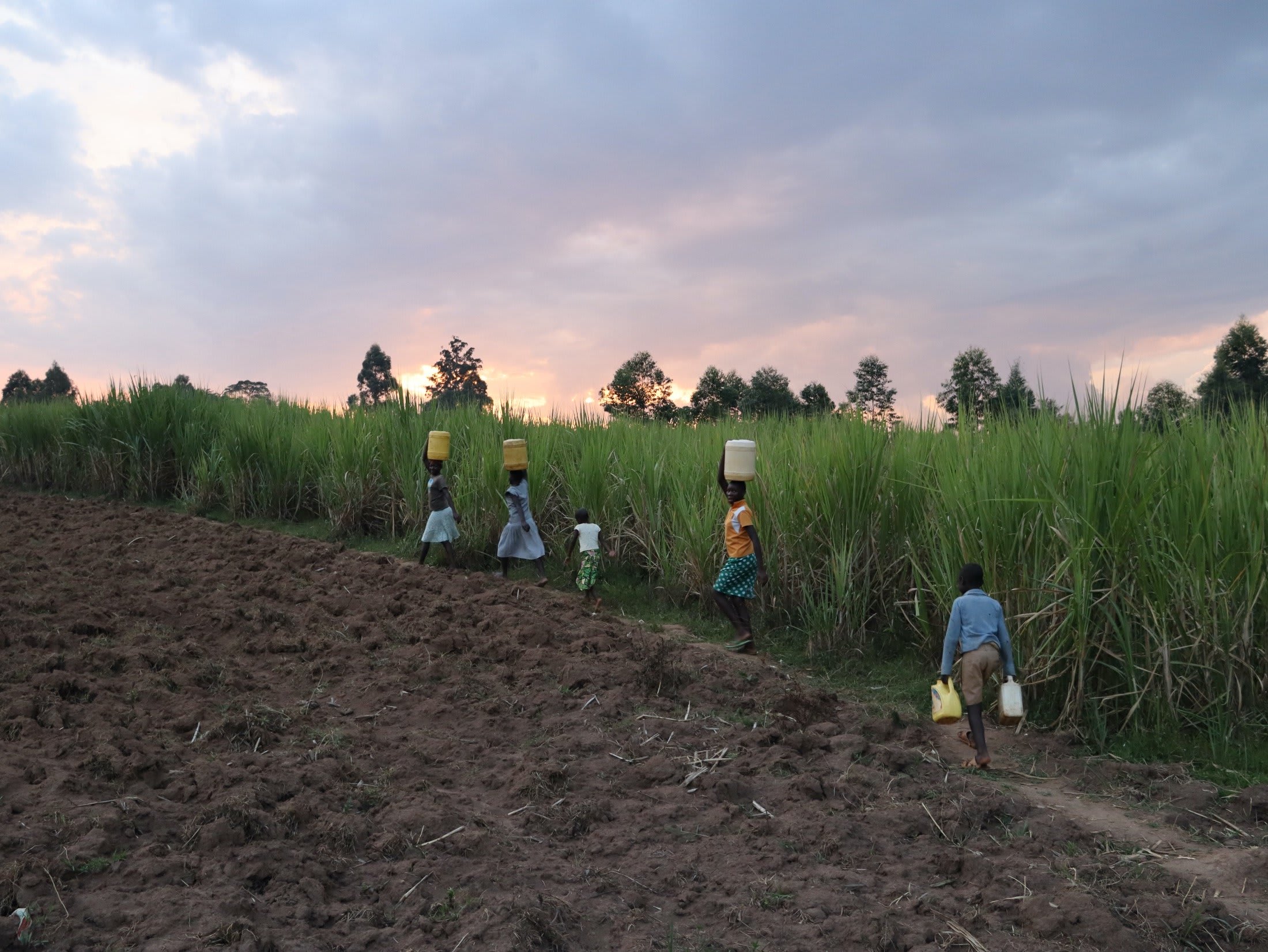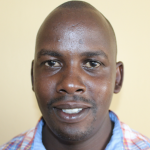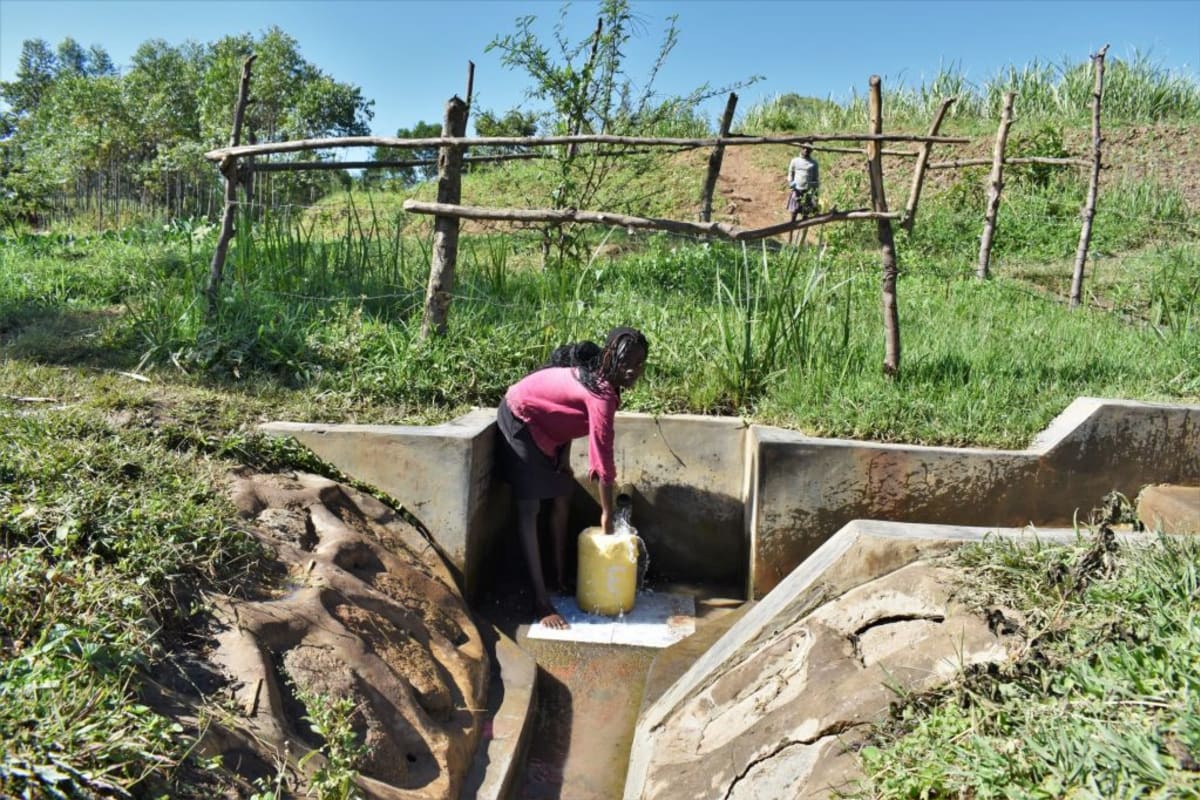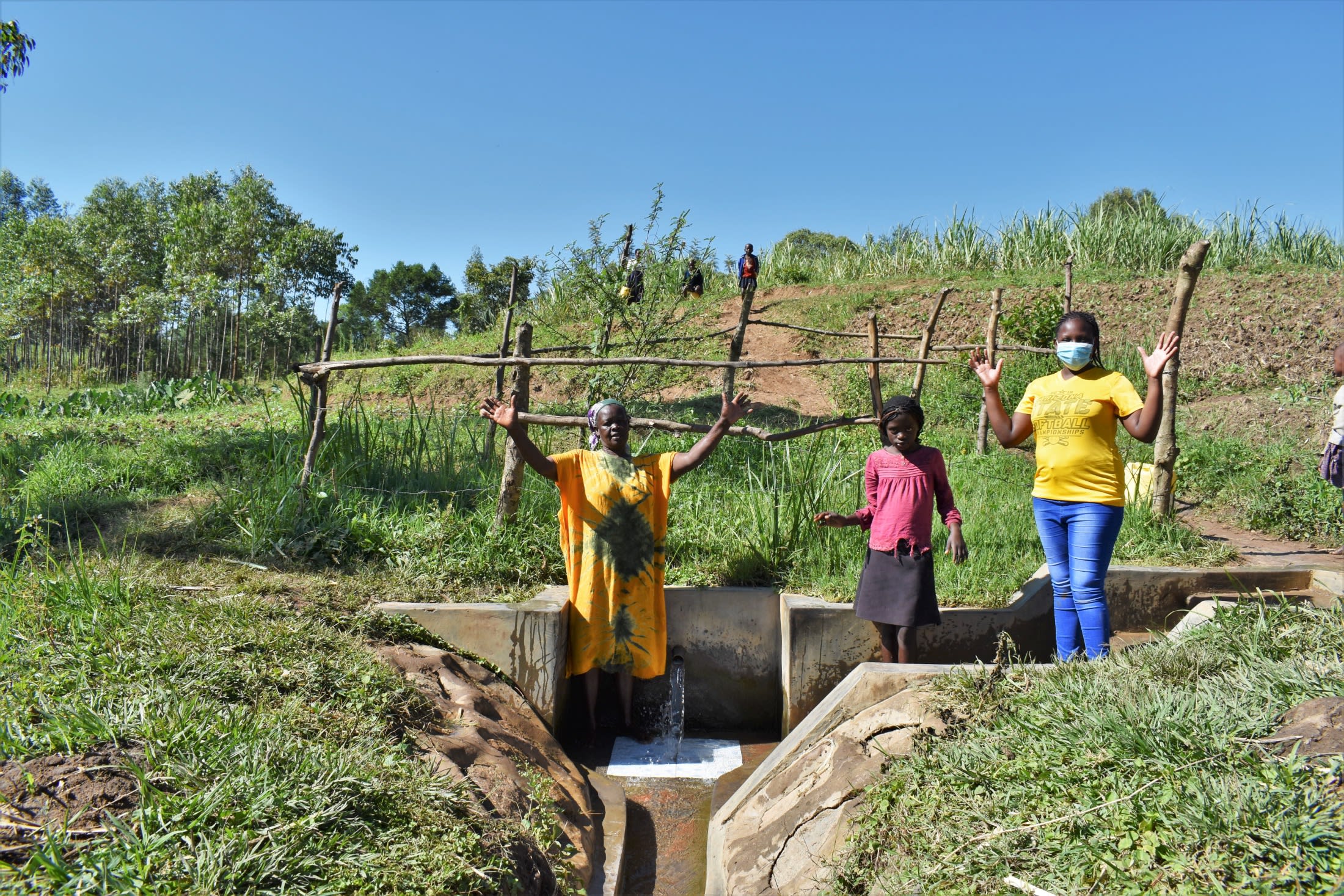Life in Mukhuyu, Kenya
Chisombe Spring is located in the village Mukhuyu in a region known for producing sugarcane as a cash crop. Together with the other crops and trees grown there, the area looks very green. The environment ranges from fairly flat to gradual slopes. The communication networks in the area are still developing, and there is not a single tarmac road in the area. Yet, the majority of roads here are fairly good and even passable even in the rainy season.
Buildings in the community range from temporary to semi-permanent and permanent ones. The temporary ones are made of mud walls and grass-thatched roofs, while the semi-permanent ones are walled with mud and roofed with iron sheets. Permanent ones are made of bricks or soft stones at the walls and roofed with the iron sheets as well.
The most common livelihood in Mukhuyu is farming, which people depend on for both subsistence and cash crops. They grow sugar cane on a small scale as their cash crop, and they also grow sweet potatoes, cassava, beans, sorghum, and maize on a small scale for consumption though surpluses are taken for sale.
Mukhuyu is full of hard-working people. Neighbors assist each other with farming and harvesting. With repeated land fragmentation made over the years among people's plots, boundaries are made of temporary plants only.
During the plowing season, anyone whose farm plot is land-locked by others' plots are allowed to pass through others' lands with their plow without any complaints or worry. This is indeed a special place filled with unity.

Relying on Contaminated Water
Water is an essential commodity to everyone in this community, as in any place. The water crisis in Mukhuyu means everyone has to base their schedules on the distance and time it will take them to get to and from the water source at Chisombe Spring each day.
Every morning, women wake up at 6:00 am to prepare breakfast for their families before going to fetch water for drinking and other household chores to give them time to engage in other activities later. The priority is always going for water, and only afterward can other activities begin after ensuring there is sufficient water for daily use in each household.
Chisombe Spring serves 180 people, most of whom have to make 6 trips to the spring and back every day to fetch enough water for all of their drinking, cooking, and cleaning needs. On laundry days, that number increases. Each walk takes from 15 minutes to 1 hour, depending on where community members live in relation to the spring.
That is a lot of time spent on fetching water, especially considering the water is not even safe for consumption.
Community members face a lot of challenges at the spring. The water point is not well-constructed, hence they can easily collect dirty water from the runoff that joins the spring water and mixes into what comes out of the discharge pipes. The runoff includes farm chemicals, animal waste, human waste, and dirt.
The other challenge is that for people to collect water from the spring, they must either step directly into the pool of water below the spring or awkwardly strain to reach the fixed plastic pipe straddling the water's edge. Either way is uncomfortable and can lead to tricky maneuvers trying to remove the full water container that can then lead to stumbles, spilled water, injuries, and more wasted time refilling containers.
"Upon arriving at Chisombe spring, I met some young girls and boys fetching water at the spring," recalled Field Officer Jonathan Mutai, the project manager for this community.
"Two were inside the pool of water at the drawing point, collecting water. This was not good to me because it was a cold evening and the kids had to step in the water."
Wet feet, shoes, and clothing can easily lead to illness when they do not get warm and dry soon enough. Jonathan also noted that though the water coming out of the spring's eye was clear, the water coming out of the pipes was not. This indicated how soon the water was being contaminated with runoff in its open state.
Malia, who works as a local businessperson and was drawing water at Chisombe spring, said that she has been a victim of typhoid and coughing after using water for drinking from the spring. According to her, the waterborne diseases are common in the area, especially during the rainy season of the year.
"Our spring does discharge a lot of water. But the problem is drawing water from it," Malia said.
"Every time I send my boy to come and fetch water here, on his return I usually find his trousers very wet because for him to collect water he has to step into a water pool at the collection point. We are kindly requesting you to consider our spring for construction so that we can end all the challenges associated with this spring."
Young teen Esther relayed similar frustrations with the spring as Malia.
"Drawing water from this spring is very challenging and hectic because every time you have to step in cold water in order to collect water. Sometimes you must be careful so as not to immerse the container to the dirty water in the drawing point."
Fortunately, Chisombe Spring has never gone dry and even in its unprotected state, its yield is strong enough that the community has improvised 2 discharge pipes to aid in collecting water. Once all of the spring's eyes are directed into the protected spring's catchment area, this yield should only improve and community members will be able to fetch water without having to deal with a pool of water.
Most of the pit latrines in this community are in poor shape. Their wooden bases get rotten with time due to leaky roofs, making the logs questionable in terms of their ability to hold someone's weight. At times the logs are prone to termite invasions as well, making them nonfunctional until the termites leave or chew through the wood entirely. Some people still share latrines with neighbors if they do not have their own.
Generally, good sanitation and hygiene practices in this community are wanting. We spotted very few dishracks and fewer clotheslines in household compounds, and no handwashing points.
What We Can Do:
Spring Protection
Protecting the spring will help provide access to cleaner and safer water. Construction will keep surface runoff and other contaminants out of the water. With the community’s high involvement in the process, there should be a good sense of responsibility and ownership for the new clean water source.
Fetching water is a task predominantly carried out by women and young girls. Protecting the spring and offering training and support will, therefore, help empower the female members of the community by freeing up more of their time and energy to engage and invest in income-generating activities and their education.
Training
We will hold a 1-day intensive training on improved hygiene, health, and sanitation habits in this community. With the community’s input, we will identify key leverage points where they can alter their practices at the personal, household, and community levels to affect change. This training will help to ensure participants have the knowledge they need about healthy practices and their importance to make the most of their water point as soon as water is flowing.
Our team of facilitators will use Participatory Hygiene and Sanitation Transformation (PHAST), Community-Led Total Sanitation (CLTS), Asset-Based Community Development (ABCD), group discussions, handouts, and demonstrations at the spring to cover a wide variety of topics.
One of the most important issues we plan to cover is the handling, storage, and treatment of water. Having a clean water source will be extremely helpful, but it is useless if water gets contaminated by the time it is consumed. We will also emphasize the importance of handwashing. We and the community strongly believe that all of these components will work together to improve living standards here, which will help to unlock the potential for these community members to live better, healthier lives.
We will then conduct a series of follow-up trainings before transitioning to our regularly scheduled support visits throughout the year.
Training will result in the formation of a committee, elected by their peers, that will oversee the operations and maintenance of the spring. The committee will enforce proper behavior around the spring and delegate tasks that will help preserve the site, such as building a fence and digging proper drainage channels. The fence will keep out destructive animals and unwanted waste, and the drainage will keep the area’s mosquito population at a minimum.
Sanitation Platforms
At the end of training, participants will select 5 families that should benefit from new concrete latrine floors called sanitation platforms. Training will inform the community and selected families on what they need to contribute to make this project a success. They must mobilize locally available materials, including bricks, clean sand, and gravel. The 5 families chosen for sanitation platforms must prepare by sinking a pit for the sanitation platforms to be placed over.
All community members must work together to make sure that accommodations and food are always provided for the work teams. The families will then be asked to complete their latrines by constructing a superstructure over their platforms. These 5 sanitation platforms will then serve as examples for the rest of the community to replicate.

 Protected Spring
Protected Spring
 Rehabilitation Project
Rehabilitation Project



















































